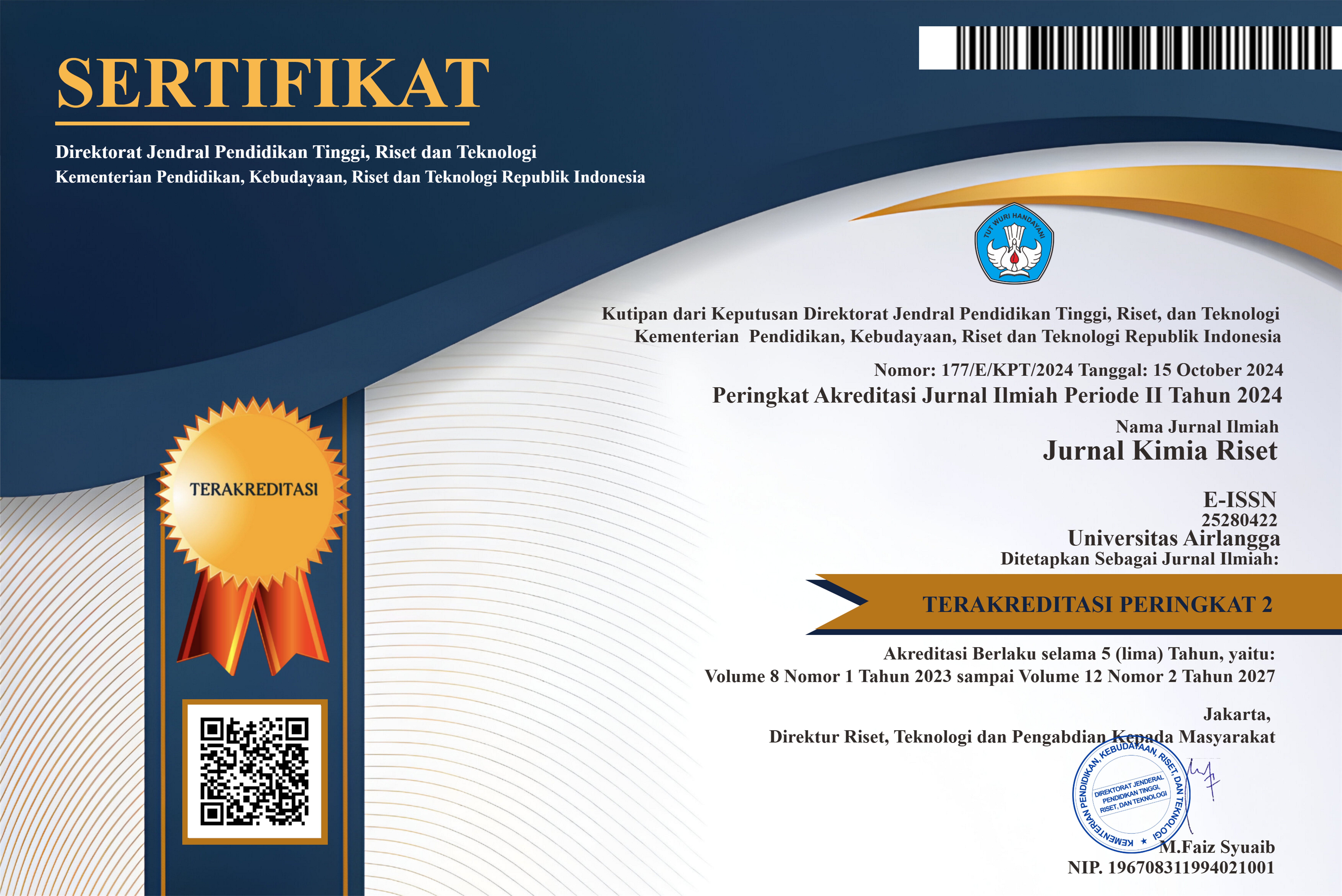In Vitro Inhibitory Activity of the α-Glucosidase Enzyme from Eucheuma cottonii Macroalgae Extract
Downloads
Diabetes mellitus is a metabolic disorder caused by damage to the pancreas, insulin resistance, or other factors. α-glucosidase inhibitors are compounds that can prevent the breakdown of complex carbohydrates into glucose, so α-glucosidase inhibitors have the potential to be used as diabetes drugs. One of the natural marine ingredients that has the potential to act as an antidiabetic is the macroalgae Eucheuma cottoniii. This research aims to determine the potential of Eucheuma cottoniii extract in inhibiting the activity of the α-glucosidase enzyme extract using an in vitro approach. Eucheuma cottoniii was extracted by a multistage maceration method used n-hexane, ethyl acetate and 70% ethanol as solvents. Extracts were characterized by the TLC method. The α-glucosidase inhibitory activity was tested in vitro used a microplate reader at 405 nm. TLC analysis results showed that the extract of Eucheuma cottonii contained flavonoid, phenol, alkaloid, steroids, and terpenoid. The α-glucosidase enzyme inhibition activity test showed that the IC50 values of the n-hexane, ethyl acetate and 70% ethanol extracts were 567.84; 174.32 and 99.57 μg/mL, while the IC50 of acarbose as a comparison was 64.41 μg/mL. It can be concluded that Eucheuma cottoniii extract with 70% ethanol has strong α-glucosidase enzyme inhibitory activity, so it has the potential to be developed as an alternative in antidiabetic treatment.
Thomas, R. L., Halim, S., Gurudas, S., Sivaprasad, S., & Owens, D. R. (2019). IDF Diabetes Atlas: A review of studies utilising retinal photography on the global prevalence of diabetes related retinopathy between 2015 and 2018. Diabetes research and clinical practice, 157, 107840.
Dipiro JT, Wells BG, S. T. and D. C. (2015). Pharmacotherapy Handbook. (M. Hill, Ed.) (Ninth Edit). New York: McGraw-Hill Education Companies.
Permata Yuda, I., Aryenti, A., & Juniarti, J. (2019). Aktivitas Inhibitor α-Glukosidase Ekstrak Daun Toona sureni (Bl.) Merr. sebagai Antihiperglikemik. Majalah Kesehatan Pharmamedika, 10(2), 063. https://doi.org/10.33476/mkp.v10i2.724
DiNicolantonio, J. J., Bhutani, J., & O’Keefe, J. H. (2015). Acarbose: safe and effective for lowering postprandial hyperglycaemia and improving cardiovascular outcomes. Open Heart, 2(1), e000327. https://doi.org/10.1136/openhrt-2015-000327
Ademiluyi, A. O., & Oboh, G. (2013). Soybean phenolic-rich extracts inhibit key-enzymes linked to type 2 diabetes (α-amylase and α-glucosidase) and hypertension (angiotensin I converting enzyme) in vitro. Experimental and Toxicologic Pathology, 65(3), 305–309. https://doi.org/10.1016/j.etp.2011.09.005
Handayani, T. (2017). Potensi Makroalga di Paparan Terumbu Karang Perairan Teluk Lampung The Potency of Macroalgae in the Reef Flat of Lampung Bay. Oseanologi Dan Limnologi Di Indonesia, 2(March 2009), 55–67.
Sambodo, D. K. (2019). Aktivitas antioksidan kombinasi ekstrak rumput laut merah (Eucheuma cottoniii) Sumbawa dan ekstrak kulit buah jeruk lemon (Citrus lemon. L) impor. Jurnal Ilmiah Farmasi, 15(2), 86-91.
Kurnia, D., Akbar, H. A., & Suhardiman, A. (2022). AKTIVITAS ANTIBAKTERI EKSTRAK DAN FRAKSI MAKROALGA Eucheuma cottoniii TERDELIGNIFIKASI TERHADAP BAKTERI PENYEBAB JERAWAT. INDONESIA NATURAL RESEARCH PHARMACEUTICAL JOURNAL, 7(2), 77-90.
Wijayanto, T., Hendri, M., & Aryawati, R. (2011). Studi Pertumbuhan Rumput Laut Eucheuma cottoniii Dengan Berbagai Metode Penanaman Yang Berbeda Di Perairan Kalianda, Lampung Selatan. Maspari Journal: Marine Science Research, 3(2), 51–57.
Prasasty, V. D., Haryani, B., Hutagalung, R. A., Mulyono, N., Yazid, F., Rosmalena, R., & Sinaga, E. (2019). Evaluation of antioxidant and antidiabetic activities from red seaweed (Eucheuma cottoniii). Systematic Reviews in Pharmacy, 10(1), 276–288. https://doi.org/10.5530/srp.2019.1.44
Nosa, S. P., Karnila, R., & Diharmi, A. (2020). Potensi kappa karaginan rumput laut (Eucheuma cottoniii) sebagai antioksidan dan inhibitor enzim α-glukosidase. Berkala Perikanan Terubuk, 48(2), 434-449.
Habibah, F., Kusuma, S. B. W., & Wijayati, N. (2016). Produksi Substrat Fermentasi Bioetanol Dari Alga Merah Gracilaria Verrucosa. Indonesian Journal of Chemical Science, 5(1).
Kemenkes RI. (2017). Farmakope Herbal Indonesia Edisi 2. Jakarta: Kementerian Kesehatan RI.
Susilowati, A., Dewi, C. P. Y., & Sari, S. L. A. (2019). Isolation and identification of endophytic bacteria from salak pondoh (Salacca edulis) fruit as αglycosidase inhibitor producer. Biosaintifika: J Biol Biol Educ, 11(3), 352-359.
Anggadiredja, J. T. (2011). Rumput Laut. Jakarta: Penebar Swadaya.
Handayani, S., Wirasutisna, K. R., & Insanu, M. (2017). Penapisan fitokimia dan karakterisasi simplisia daun jambu mawar (syzygium jambos alston). Jurnal farmasi UIN Alauddin Makassar, 5(3), 174-183.
Forestryana, D., & Arnida, A. (2020). Skrining Fitokimia Dan Analisis Kromatografi Lapis Tipis Ekstrak Etanol Daun Jeruju (Hydrolea Spinosa L.). Jurnal Ilmiah Farmako Bahari, 11(2), 113. https://doi.org/10.52434/jfb.v11i2.859
Yuniarto, A., & Selifiana, N. (2018). Aktivitas Inhibisi Enzim Alfa-glukosidase dari Ekstrak Rimpang Bangle (Zingiber cassumunar Roxb.) secara In vitro. MPI (Media Pharmaceutica Indonesiana), 2(1), 22–25. https://doi.org/10.24123/mpi.v2i1.1299
Fadhli, H., Nurdin A, N., & Sandi N, H. (2021). AKTIVITAS INHIBISI ENZIM αGLUKOSIDASE DARI EKSTRAK KULIT BATANG BUNGA KUPU-KUPU (Bauhinia semibifida Roxb) SECARA IN VITRO. Jurnal Ilmiah Ibnu Sina, Vol. 6.
Dwiatmi Dewiyanti, I., Filailla, E., Megawati, M., & Yuliani, T. (2012). Antidiabetic Activity of Cocor Bebek Leaves (Kalanchoe pinnata Lam.Pers.) Ethanolic Extract from Various Areas. Journal of Tropical Life Science, 2(2), 37–39. https://doi.org/10.11594/jtls.02.02.03
Febrinda, A. E., Astawan, M., Wresdiyati, T., & Dewi Yuliana, N. (2013). Kapasitas Antioksidan Dan Inhibitor Alfa Glukosidase Ekstrak Umbi Bawang Dayak. Jurnal Teknologi Dan Industri Pangan, 24(2), 161–167. https://doi.org/10.6066/jtip.2013.24.2.161
Copyright (c) 2025 Jurnal Kimia Riset

This work is licensed under a Creative Commons Attribution-NonCommercial-ShareAlike 4.0 International License.
COPYRIGHT NOTICE
1. By submitting the article to Jurnal Kimia Riset (JKR), the author has agreed to transfer some of the copyrights to the publisher of the research chemistry journal, Universitas Airlangga, indicated in the Copyright Transfer Agreement.
2. Authors still retain significant rights to use and share their own published articles for non-commercial purposes subject to Creative Commons Attribution-NonComercial 4.0 International License
3. All publications (printed/electronic) are open access for educational purposes, research, library, and other non-commercial purposes. Besides the purposes mentioned above, the editorial board is not responsible for copyright violations.















